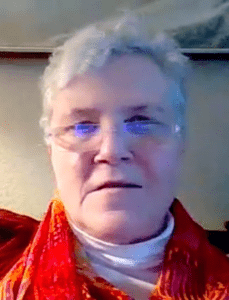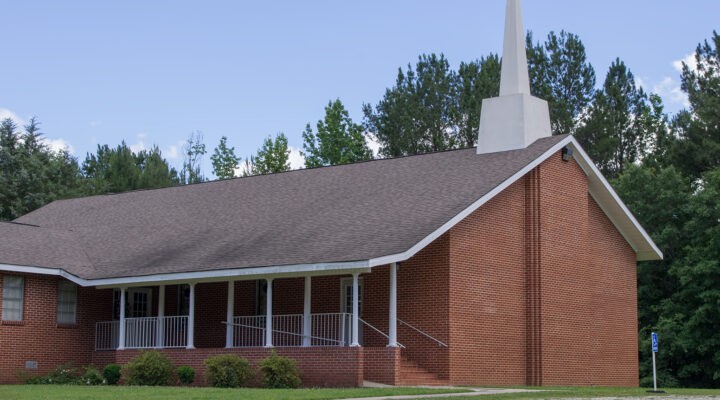The pandemic shoved most small American churches further into a post-denominational reality but also demonstrated their capability of surviving in a post-Christian culture, according to congregational consultant and coach Deborah Wright.
She spoke during a recent webinar on the challenges facing small churches presented by the Center for Healthy Churches.
“We did find a couple things in the pandemic, including that we do have an adaptive change muscle. We changed when we had to,” she said. “A lot of the work with these smaller churches is about exercising that adaptive muscle not because it sounds like a fun thing to experiment with, but because it’s a matter of survival and sustainability.”
 Wright is co-founder of PneuMatrix, a nonprofit focused on helping Presbyterian congregations and regional jurisdictions, known as presbyteries, through the challenges of adaptive change in a post-Christian world.
Wright is co-founder of PneuMatrix, a nonprofit focused on helping Presbyterian congregations and regional jurisdictions, known as presbyteries, through the challenges of adaptive change in a post-Christian world.
She served as moderator of the webinar, joined by three panelists from Western states selected for their experience and insight navigating the turbulent social and cultural trends that affected their regions decades before showing up in other parts of the country, said Matt Cook, assistant director of the Center for Healthy Churches.
The session was part of “Postcards from the Edge,” a three-part series that also addressed multicultural congregations and cultural shifts facing churches.
 “This webinar is dedicated to help ministers and congregations ask good and challenging questions amidst all the tremendous changes taking place that create opportunities and obstacles,” Cook said. “If we ask the question, ‘Where are the changes occurring first?’ oftentimes, culturally, the answer to that is the West Coast. So, we have had some friends out on the West Coast talking to us about what it’s like to experience post-Christendom. They’ve been in it for a long time.”
“This webinar is dedicated to help ministers and congregations ask good and challenging questions amidst all the tremendous changes taking place that create opportunities and obstacles,” Cook said. “If we ask the question, ‘Where are the changes occurring first?’ oftentimes, culturally, the answer to that is the West Coast. So, we have had some friends out on the West Coast talking to us about what it’s like to experience post-Christendom. They’ve been in it for a long time.”
But threats to congregational life previously experienced in states like California, Oregon and Washington have no doubt spread to congregations throughout the Presbyterian Church USA, Wright said. One of those trends is dwindling attendance.
“We have over two-thirds of our congregations that have fewer than 100 members. You have to go up to the 82nd percentile to get to a church with 200 members,” she said. “I’m sure that’s true of other denominations represented here.”
Wright referenced a study by Georgia Tech analytics expert Bill Drummond that warned all congregations of fewer than 100 people will disappear by 2030 if they do not find new ways of doing church. “That’s a 2-by-4 right between the eyes,” she said.
Faith Community Today’s “Twenty Years of Congregational Change” report documented the trajectory of small congregations on a wide scale, finding that a significant majority of American churches (70%) have 100 or fewer weekly attendees and that the percentage continues to rise. “It remains to be seen what the post-pandemic situation will bring, but early indications suggest this trend will likely accelerate over the next decade.”
The survey also found that the majority of American congregations are “growing older, smaller and, by many measures, less vital” as smaller congregations continue to get smaller. “At least 175,000 faith communities (half of 350,000) in the country have 65 or fewer people in attendance on any given weekend.”
“It remains to be seen what the post-pandemic situation will bring, but early indications suggest this trend will likely accelerate over the next decade.”
Other challenges these churches face include having unpaid or bivocational clergy and part-time religious leaders, mostly empty sanctuaries during worship and higher budget expenses per capita.
But the Faith Communities Today report also noted signs of resilience, vibrancy, vitality and optimism in many congregations, even smaller ones, emerging from the COVID-19 pandemic.
“The smallest 70% of congregations — those with worship attendance of 100 or less— were characterized as having a high level of member commitment,” the researchers said. “These faith communities had a greater percentage of member participation in weekly worship. Their participants gave more money per person and were more likely to volunteer. These congregations spent less on staffing costs and gave the highest percentage of their budgets in support of missions and charity.”
Panelists described a number of examples of small congregations demonstrating the ingenuity and drive needed to continue ministry and worship in a post-Christian age exacerbated by the coronavirus outbreak.
 Among them was a small Presbyterian church in the Northwest that rents its sanctuary to a Lutheran congregation. Neither congregation had a pastor, recalled Ariel Mink, a commissioned ruling elder, bivocational lay pastor and stated clerk of the Presbytery of the Redwoods, which includes 47 congregations stretching along the northern California coast to the Oregon border.
Among them was a small Presbyterian church in the Northwest that rents its sanctuary to a Lutheran congregation. Neither congregation had a pastor, recalled Ariel Mink, a commissioned ruling elder, bivocational lay pastor and stated clerk of the Presbytery of the Redwoods, which includes 47 congregations stretching along the northern California coast to the Oregon border.
With both pastoral searches under way, “it dawned on them … to look for one (candidate) to serve both congregations. They acted as one body seeking one pastor,” Mink said. They ended up calling a Lutheran minister and eventually the two groups worshiped together during the pandemic. They have since decided “to stay together as one congregation rather than two distinct congregations.”
Panelist Scott Crane said his part-time pastor arrangement with a small church in the Presbytery of the Cascades, which includes 96 congregations in portions of California, Oregon and Washington, as inspiring.
 Crane said he makes the drive to conduct services on Sunday mornings, stays the day providing pastoral care and visiting members’ homes, and returns home the next day. In the meantime, church members handle all the other duties and needs associated with the congregation.
Crane said he makes the drive to conduct services on Sunday mornings, stays the day providing pastoral care and visiting members’ homes, and returns home the next day. In the meantime, church members handle all the other duties and needs associated with the congregation.
“They have a unique mindset, a left-over pioneering spirit,” Crane said of the small church located 90 miles from his home. “They take care of themselves and pull themselves up by their bootstraps without my finger on the pulse of the congregation a lot of the time.”
Much freedom and creativity actually can be found by going intentionally small, said Brett Webb-Mitchell, director of the School of the Pilgrim, an intentional Christian community based near Portland, Ore.

Brett Webb-Mitchell
Webb-Mitchell helped launch the group with just under 20 people after other churches passed on him as an openly gay pastor.
“For me, shifting that to the intentional Christian community, to a Benedictine model, to a smaller community of faith trying to be a community first — that has worship, that has service, that has fellowship — changes the dynamics quite a bit. Our pledges last year, even with 15, 16 people was over $17,000.”
Related articles:
Largest-ever U.S. congregational survey confirms what church consultants have been telling you
Most comprehensive study yet of COVID’s impact on churches finds uneven results


